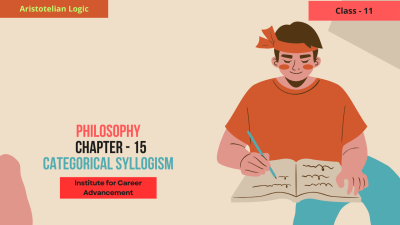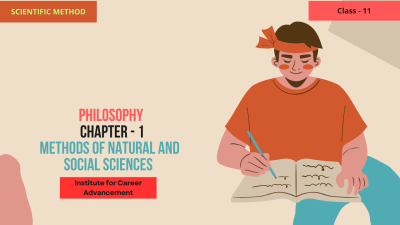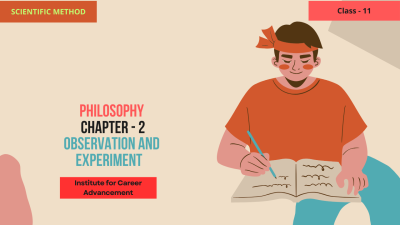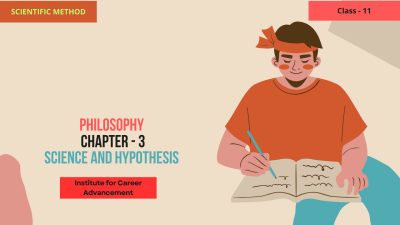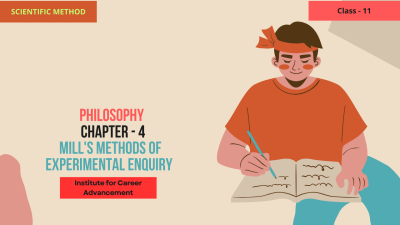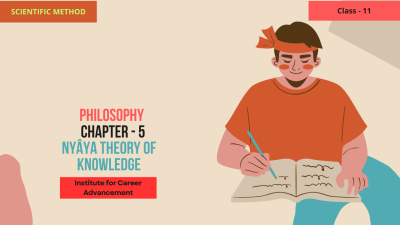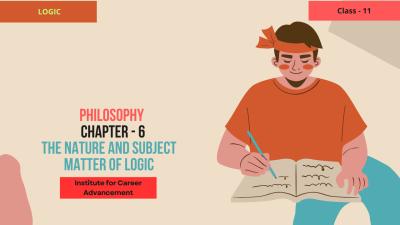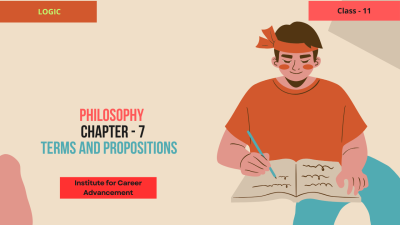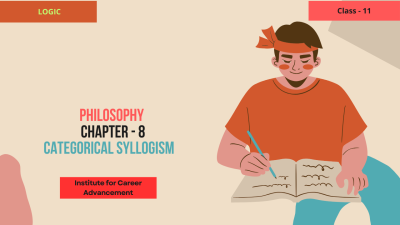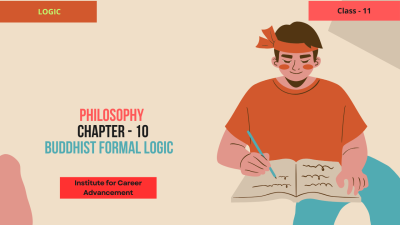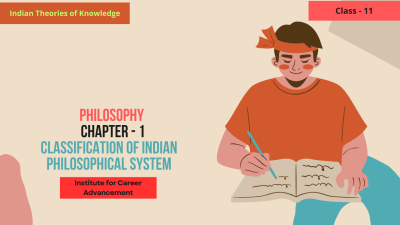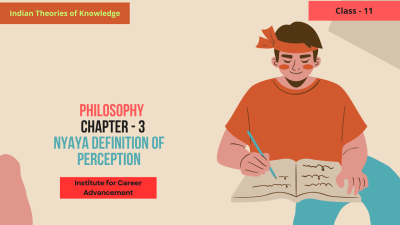Course description
The topic "Categorical Syllogism" in the Class 11 logic curriculum focuses on understanding the structure of logical arguments that involve categorical propositions. A categorical syllogism is a type of deductive argument consisting of three categorical propositions: two premises and a conclusion. The study of categorical syllogisms helps students develop reasoning and critical thinking skills, enabling them to evaluate the validity of logical arguments systematically.
Key Concepts Covered:
1. Introduction to Categorical Syllogism
Definition: A categorical syllogism is an argument composed of three categorical propositions: two premises and one conclusion.
Premises: Statements that provide the basis of the argument.
Conclusion: A statement derived from the premises.
Structure: A typical syllogism consists of:
Major Premise: The first premise, which contains the major term.
Minor Premise: The second premise, which contains the minor term.
Conclusion: The statement that logically follows from the premises.
2. The Terms in a Syllogism
Major Term: The predicate of the conclusion.
Minor Term: The subject of the conclusion.
Middle Term: The term that appears in both premises but not in the conclusion. It serves to connect the major and minor terms.
Students will learn how these terms interact in forming valid syllogisms.
3. Types of Categorical Propositions in a Syllogism
Universal Affirmative (A): "All S are P."
Universal Negative (E): "No S are P."
Particular Affirmative (I): "Some S are P."
Particular Negative (O): "Some S are not P."
Understanding how these propositions fit into the structure of syllogisms is crucial for identifying valid and invalid arguments.
4. The Rules for Valid Syllogisms
Students will learn the rules of valid syllogisms, which include:
Rule 1: The syllogism must contain exactly three terms: major, minor, and middle.
Rule 2: The middle term must be distributed at least once.
Rule 3: A term that is distributed in the conclusion must be distributed in the premises.
Rule 4: A valid syllogism cannot have two negative premises.
Rule 5: A valid syllogism cannot have a negative conclusion with two affirmative premises.
5. The Mood and Figure of a Syllogism
Mood: Refers to the types of categorical propositions (A, E, I, O) used in the syllogism.
For example, a syllogism with the form "A, E, I" would be referred to as having the mood A, E, I.
Figure: Refers to the arrangement of the middle term in the premises. There are four figures in categorical syllogisms:
Figure 1: The middle term is the subject in the major premise and the predicate in the minor premise.
Figure 2: The middle term is the predicate in both premises.
Figure 3: The middle term is the subject in both premises.
Figure 4: A variant of the other three figures.
6. Validity of Syllogisms
Validity: A syllogism is valid if the conclusion logically follows from the premises, regardless of the truth of the premises. Students will learn how to apply rules and use diagrams (such as Venn diagrams) to determine the validity of syllogisms.
Testing Validity: Understand how to check for the validity of syllogisms using techniques such as:
Venn diagrams.
The Aristotelian method (classifying terms as distributed or undistributed in the premises).
7. Common Logical Fallacies in Syllogisms
Fallacies of Four Terms: Occur when a syllogism contains more than three terms.
Fallacies of the Undistributed Middle: Occur when the middle term is not distributed in at least one of the premises.
Exclusive Premises Fallacy: Occurs when both premises are negative.
Affirmative Conclusion from Negative Premises: A syllogism cannot have an affirmative conclusion if both premises are negative.
8. Application of Categorical Syllogisms in Real-Life Reasoning
Understanding how to use categorical syllogisms in reasoning and decision-making, such as in legal arguments, scientific reasoning, or philosophical discussions.
Recognizing the role of valid syllogisms in constructing logical, persuasive arguments.
একাদশ শ্রেণির যুক্তিবিজ্ঞান পাঠ্যক্রমের বিষয় "শ্রেণীগত সিলেজিজম" যুক্তিসঙ্গত আর্গুমেন্টের কাঠামো বোঝার উপর দৃষ্টি নিবদ্ধ করে যা শ্রেণীবদ্ধ প্রস্তাবনাগুলির সাথে জড়িত। একটি শ্রেণীগত শব্দাংশ হল এক ধরনের অবরোহী যুক্তি যা তিনটি শ্রেণীগত প্রস্তাব নিয়ে গঠিতঃ দুটি ভিত্তি এবং একটি উপসংহার। শ্রেণীবদ্ধ সিলেজিজমের অধ্যয়ন শিক্ষার্থীদের যুক্তি এবং সমালোচনামূলক চিন্তাভাবনার দক্ষতা বিকাশে সহায়তা করে, যা তাদের পদ্ধতিগতভাবে যৌক্তিক যুক্তির বৈধতা মূল্যায়ন করতে সক্ষম করে।
অন্তর্ভুক্ত মূল ধারণাগুলিঃ
1টি। শ্রেণীগত সিলেজিজমের পরিচিতি
সংজ্ঞাঃ একটি শ্রেণীগত শব্দাংশ হল তিনটি শ্রেণীগত প্রস্তাবনা নিয়ে গঠিত একটি যুক্তিঃ দুটি ভিত্তি এবং একটি উপসংহার।
ভিত্তিঃ এমন বিবৃতি যা যুক্তির ভিত্তি প্রদান করে।
উপসংহারঃ প্রাঙ্গণ থেকে প্রাপ্ত একটি বিবৃতি।
গঠনঃ একটি সাধারণ সিলেজিজমের মধ্যে রয়েছেঃ
প্রধান ভিত্তিঃ প্রথম ভিত্তি, যার মধ্যে প্রধান শব্দটি রয়েছে।
গৌণ ভিত্তিঃ দ্বিতীয় ভিত্তিটি, যার মধ্যে গৌণ শব্দটি রয়েছে।
উপসংহারঃ যে বিবৃতিটি যৌক্তিকভাবে প্রাঙ্গণ থেকে অনুসরণ করা হয়।
2. একটি সিলেজিজমের শর্তাবলী
মেজর টার্মঃ উপসংহারের পূর্বাভাস।
মাইনর টার্মঃ উপসংহারের বিষয়।
মধ্য মেয়াদিঃ যে শব্দটি উভয় প্রাঙ্গণে উপস্থিত হয় কিন্তু উপসংহারে নয়। এটি বড় এবং ছোট পদগুলিকে সংযুক্ত করতে কাজ করে।
শিক্ষার্থীরা শিখবে কিভাবে এই শব্দগুলি বৈধ সিলেজিজম গঠনে মিথস্ক্রিয়া করে।
3. একটি সিলেজিজমে শ্রেণীগত প্রস্তাবের প্রকার
সর্বজনীন ইতিবাচক (এ) "সমস্ত এস পি"।
ইউনিভার্সাল নেগেটিভ (ই) "No S are P"।
বিশেষ ইতিবাচক (I) "কিছু এস পি"।
বিশেষ নেতিবাচক (ও) "কিছু এস পি নয়"।
এই প্রস্তাবগুলি কীভাবে সিলেজিজমের কাঠামোর সাথে খাপ খায় তা বোঝা বৈধ এবং অবৈধ আর্গুমেন্টগুলি সনাক্ত করার জন্য অত্যন্ত গুরুত্বপূর্ণ।
4. বৈধ সিলেজিজমের নিয়ম
শিক্ষার্থীরা বৈধ সিলেজিজমের নিয়মগুলি শিখবে, যার মধ্যে রয়েছেঃ
নিয়ম 1ঃ সিলেজিজমে অবশ্যই ঠিক তিনটি পদ থাকতে হবেঃ বড়, ছোট এবং মাঝারি।
নিয়ম 2ঃ মধ্যবর্তী পদটি অন্তত একবার বন্টন করতে হবে।
নিয়ম 3: উপসংহারে বিতরণ করা একটি শব্দ অবশ্যই প্রাঙ্গনে বিতরণ করা উচিত।
নিয়ম 4ঃ একটি বৈধ সিলেজিজমের দুটি নেতিবাচক ভিত্তি থাকতে পারে না।
নিয়ম 5ঃ একটি বৈধ শব্দাংশের দুটি ইতিবাচক ভিত্তি সহ নেতিবাচক উপসংহার হতে পারে না।
5. একটি সিলেজিজমের মেজাজ এবং চিত্র
মেজাজঃ সিলেজিজমে ব্যবহৃত শ্রেণীবদ্ধ প্রস্তাবের (এ, ই, আই, ও) প্রকারকে বোঝায়।
উদাহরণস্বরূপ, "এ, ই, আই" ফর্ম সহ একটি সিলেজিজমকে মেজাজ এ, ই, আই হিসাবে উল্লেখ করা হবে।
চিত্রঃ প্রাঙ্গনে মধ্য মেয়াদের বিন্যাসকে বোঝায়। শ্রেণীগত সিলেজিজমে চারটি চিত্র রয়েছেঃ
চিত্র 1: মধ্যম পদ হল প্রধান ভিত্তির বিষয় এবং গৌণ ভিত্তির প্রেডিকেট।
চিত্র 2: উভয় প্রেক্ষাপটে মধ্যম পদটি হল প্রেডিকেট।
চিত্র 3: উভয় প্রেক্ষাপটে মধ্যম পদটি বিষয়।
চিত্র 4ঃ অন্যান্য তিনটি চিত্রের একটি রূপ।
6টি। সিলেজিজমের বৈধতা
বৈধতাঃ একটি সিলেজিজম বৈধ যদি উপসংহারটি যৌক্তিকভাবে প্রাঙ্গণ থেকে অনুসরণ করে, প্রাঙ্গনের সত্যতা নির্বিশেষে। শিক্ষার্থীরা শিখবে কিভাবে নিয়ম প্রয়োগ করতে হয় এবং ডায়াগ্রাম (যেমন ভেন ডায়াগ্রাম) ব্যবহার করে সিলেজিজমের বৈধতা নির্ধারণ করতে হয়।
বৈধতার পরীক্ষাঃ বুঝুন কিভাবে কৌশলগুলি ব্যবহার করে সিলেজিজমের বৈধতা পরীক্ষা করতে হয় যেমনঃ
ভেন ডায়াগ্রাম।
অ্যারিস্টটলিয়ান পদ্ধতি (প্রাঙ্গনে বিতরণ বা অবিভক্ত হিসাবে পদগুলি শ্রেণীবদ্ধ করা)
7. সিলেজিজমে সাধারণ যৌক্তিক ভুল
চারটি শব্দের ভুলঃ যখন একটি সিলেজিমে তিনটির বেশি শব্দ থাকে তখন ঘটে।
অবিভক্ত মধ্যভাগের ভুলগুলিঃ যখন মধ্যবর্তী সময়টি অন্তত একটি প্রাঙ্গনে বিতরণ করা হয় না তখন ঘটে।
বিশেষ প্রাঙ্গণ ভুল ধারণাঃ যখন উভয় প্রাঙ্গণই নেতিবাচক হয় তখন এটি ঘটে।
নেতিবাচক প্রেক্ষাপট থেকে ইতিবাচক উপসংহারঃ উভয় প্রেক্ষাপটই নেতিবাচক হলে একটি সিলেজিজমের ইতিবাচক উপসংহার হতে পারে না।
8. বাস্তব জীবনের যুক্তিতে শ্রেণীবদ্ধ সিলেজিজমের প্রয়োগ
আইনি যুক্তি, বৈজ্ঞানিক যুক্তি বা দার্শনিক আলোচনার মতো যুক্তি এবং সিদ্ধান্ত গ্রহণে শ্রেণীবদ্ধ শব্দাংশ কীভাবে ব্যবহার করা যায় তা বোঝা।
যৌক্তিক, প্ররোচনামূলক যুক্তি তৈরিতে বৈধ শব্দাংশের ভূমিকাকে স্বীকৃতি দেওয়া।

